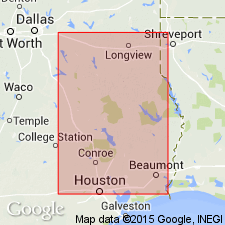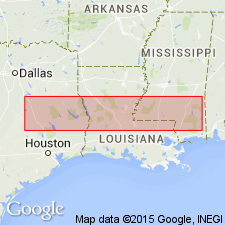
- Usage in publication:
-
- Lufkin beds or Angelina County beds
- Modifications:
-
- Original reference
- Dominant lithology:
-
- Clay
- Sand
- AAPG geologic province:
-
- East Texas basin
Summary:
Pg. 45, 58. Lufkin beds or Angelina County beds. Chiefly dark-blue gypseous clays (gray, white, and blue), sands (sometimes laminated and cross-bedded), sandy slays, and lignites, 100 or more feet thick. Basal formation of Miocene. Underlies Fayette sands and sandstones and unconformably overlies Eocene Cook's Mountain beds.
[Named from Lufkin, Angelina Co., eastern TX.]
Source: US geologic names lexicon (USGS Bull. 896, p. 1235-1236).

- Usage in publication:
-
- Lufkin beds†
- Modifications:
-
- Abandoned
- AAPG geologic province:
-
- East Texas basin
Summary:
†Lufkin beds in Claiborne group abandoned. Same as Yegua formation (Eocene), the better established name.
Source: US geologic names lexicon (USGS Bull. 896, p. 1235-1236).

- Usage in publication:
-
- Lufkin beds†
- Modifications:
-
- Abandoned
- AAPG geologic province:
-
- East Texas basin
Summary:
Pg. 885-904 [1940]. †Lufkin beds. Discussion of Yegua problem. Terms Lufkin, Yegua, and Cockfield have been used for beds herein called Yegua. Although present writer [Stenzel] has retained name Yegua, he advocated use of Lufkin as name for these beds.
Source: US geologic names lexicon (USGS Bull. 1200, p. 2273).
For more information, please contact Nancy Stamm, Geologic Names Committee Secretary.
Asterisk (*) indicates published by U.S. Geological Survey authors.
"No current usage" (†) implies that a name has been abandoned or has fallen into disuse. Former usage and, if known, replacement name given in parentheses ( ).
Slash (/) indicates name conflicts with nomenclatural guidelines (CSN, 1933; ACSN, 1961, 1970; NACSN, 1983, 2005, 2021). May be explained within brackets ([ ]).

